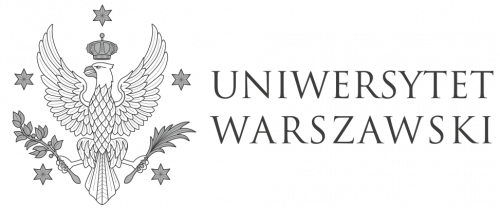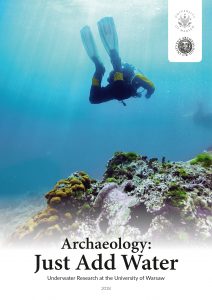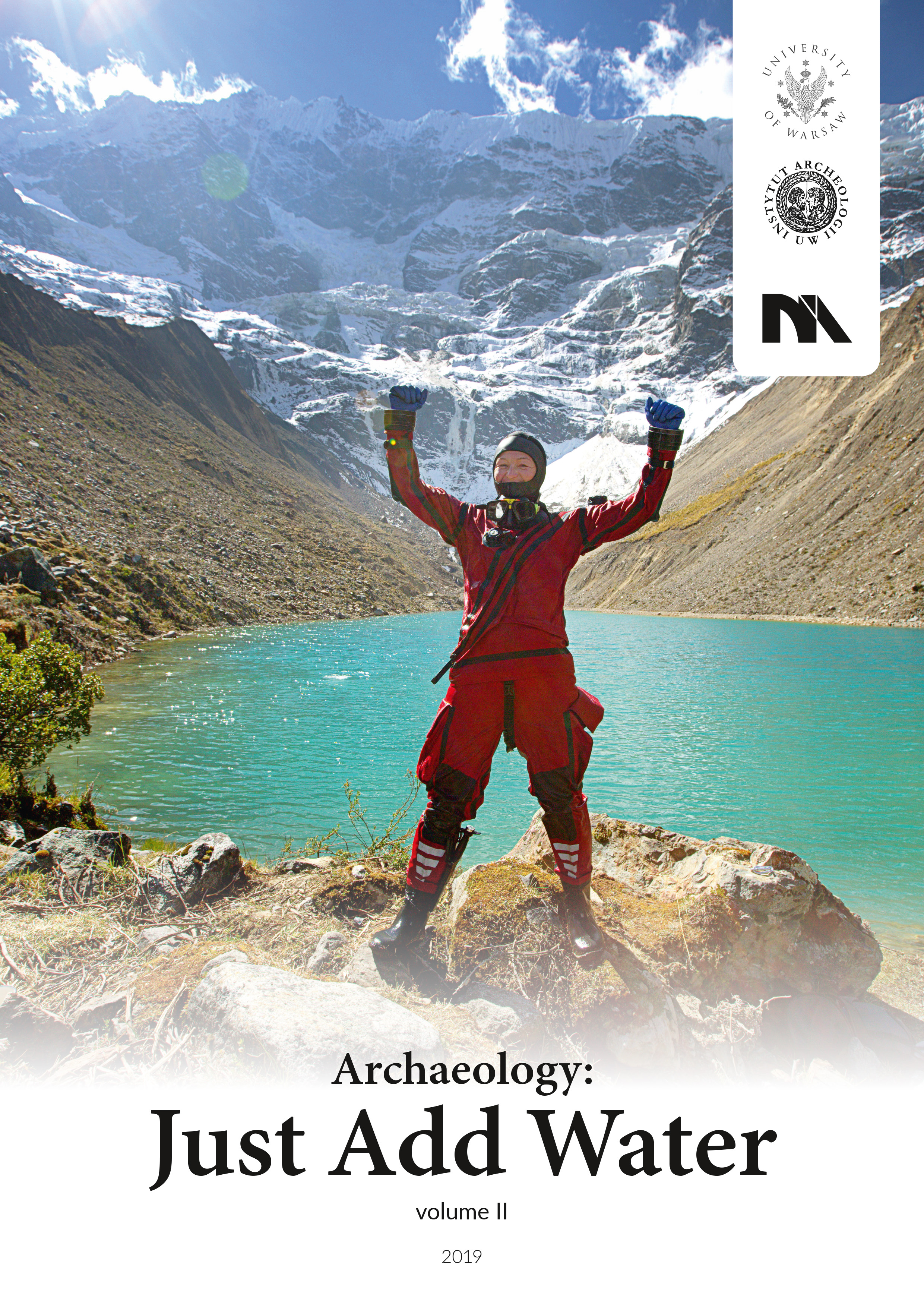Archaeology: Just Add Water „Światowit” Suppl. Series U
„Światowit” is a periodical of the Institute of Archaeology, University of Warsaw, issued since 1899.
More information about the fascicles are available here:
In 2018 the first volume of the Supplement Series U has been published, as an outcome of the 2nd Warsaw Seminar on Underwater Archaeology (2017). Second volume was issued in 2019, which was possible due to the funding from the Polish Ministry of Science and Higher Education (959/P-DUN/2018).
The submitted papers are a subject to evaluation by the editors’ board in accordance with the editorial guidelines. Then they have to be accepted by the series’ editor. After the editing process the article is subjected to an expert review of the member of the Reveiewers’ Board.
Archaeology: Just Add Water
“Światowit” Suppl. Series U, Underwater Archaeology
vol. I
Click the cover below to see the contents⇓
Archaeology: Just Add Water
“Światowit” Suppl. Series U, Underwater Archaeology
vol. II
Click the cover below to see the contents⇓
Full version:
Archaeology Just Add Water vol. II
The publication was possible due to the funding from the Polish Ministry of Science and Higher Education
(959/P-DUN/2018).
Call for Papers
Archaeology: Just Add Water
“Światowit” Suppl. Series U, vol. III
series ed. dr hab. Bartosz Kontny, prof. UW
Dear Authors,
we are pleased to invite you to submit the papers for the third volume of the underwater archaeology series edited and published at the University of Warsaw.
“Światowit” is a yearly issue of the Faculty of Archaeology, University of Warsaw, and one
of the oldest Polish archaeological periodicals (issued since 1899). In 2018 and 2019 the first two volumes of the new ‘U’ supplement series were published; they are available online
at http://underwaterexpedition.uw.edu.pl/swiatowit-suppl-series-u-underwater-archaeology/.
The Editorial Board of the series accepts articles from the field of underwater and waterfront archaeology, including the research papers, reports from fieldwork and archive studies, as well as the ones concerning newest technologies, their influence on underwater archaeology methods and, above all, the activities of certain museums and universities in the field of protection of underwater cultural heritage.
The language of the series is English.
Texts submitted to the Editorial Board undergo a review process in accordance with the rules available at the aforementioned website.
The Authors will be asked to sign publishing agreements and are entitled to a hard copy and digital version of their article in .pdf format.
The deadline for submission of the articles for the III volume is the 31st of May 2021.
Papers should be sent via e-mail to underwaterexpedition@uw.edu.pl.
The Editorial Board of “Światowit” Suppl. Series U
Address:
Faculty of Archaeology, University of Warsaw
Krakowskie Przedmieście 26/28, 00-927 Warszawa, Poland
GUIDELINES FOR THE AUTHORS
III volume
The maximum length of the article (Main Text + Reference List) is 80 000 signs with spaces. The number of figures is not limited, although the Editing Board might suggest some changes if it finds them necessary.
Font: Times New Roman 12; space 1.5; margins: 2.5 cm;
Title
in bold; centred
Full name of the Author[1], academic title or degree
Affiliation
E-mail address
(above the text, on the left)
ORCID no.
Abstract:
between 1 600 and 1 800 characters with spaces.
Keywords:
up to 10, in minuscule, separated with commas.
Main text:
- page numbers – bottom middle;
- reference to figures – in parentheses, with continuous Arabic numeration (Fig. 1);
- foreign terms, not present in the Oxford English Dictionary – in italics;
- if applicable, please follow the rules of the scientific transliteration and add
the original in parentheses; this rule applies also to the Reference List; - in case special fonts are to be used in the text, e.g. for ancient languages, they should be made available to the Editorial Board;
- geographical names should be accompanied with their location in parentheses, including region (not a name of a district or commune) and state, e. (Pomerania, Poland);
- anthroponyms – if the text refers to a person for the first time, she/he should bementioned by both the first name (full, not as initial) and name, later only the name – no initials should be used in the main text;
- archaic proper names – in italics;
- please use abbreviations C. and A.D., accordingly;
- for date ranges no space and a dash (not a hyphen!) should be used
(e.g. 2007–2012, not 2007-2012); - for emphasis, use upper apostrophes ‘’;
- quotations: in italics and double quotation marks “”; longer quotations (more than 50 words) should be included in the separate paragraph; all should be followed
by the reference, according to guidelines below; if the citation was translated
by the Author, it has to be stated before the reference and the original text should be included in the footnote; - modified Oxford reference: in parentheses – name(s), year, colon, page/page range[2]/figure no., or page/page range and figure no. separated with a comma;
example 1: (Molina Gómez 2004: 2–5)
example 2: (Molina Gómez 2004: 5, fig. 4)
for two authors:
example 3: (Molina Gómez and Zapata Parra 2014: 207–212)
for three authors and more (et al. in italics)
example 4: (Molina Gómez et al. 2004: 4)
for written and other ancient sources the Author should use the abbreviations the rules
of The Oxford Classical Dictionary available at http://classics.oxfordre.com/page/abbreviation-list/
example 5: (Juv. Sat. of Juv. V)
if the source is not included in the Oxford list, the Author should include in the reference the whole title of the source or, if possible, reference as in examples 1–4
example 6: (Geographica hypomnemata 16.2)
for the source is cited after the publication:
example 7: (Codex Diplomaticus Silesiae: no. 6; after: Dembińska 1973: 64)
if multiple authors are cited in the same reference, they should be separated with a semi-colon:
example 8: (Garcia and Vital 2005: 64; Sourisseau 2010: 238; Ugolini 2010: 32)
if giving reference to more than one work by the same author, the latter should state only the year
of publication (and pages), separated by a semi-colon; the sources should be arranged in chronological order:
example 9: (Molina 2004: 4; 2010: 15)
while referring to the author in the text, the actual reference should contain only the year of publication:
example 10: According to Julia Scapova (1973: 15);
- literature reference list: should be added right below the main text
(see information on Reference List below); - the list of figures (all illustrations and tables, with continuous Arabic numeration) should be included after the literature Reference List, with the captions and full reference to the source; in case the Author uses figures different than (1) own,
or (2) available within the Public Domain, or (3) one of the Creative Commons licences (Attribution 4.0 International; Attribution-NonCommercial 4.0 International; Attribution-NonCommercial-ShareAlike 4.0; International Attribution-NonCommercial-
-NoDerivatives 4.0 International; Attribution-NoDerivatives 4.0 International; Attribution-ShareAlike 4.0 International) accordingly, the permissions from the original author/owner are necessary; paper’s Author will be asked to provide the ‘confirmation of copyrights’, a statement of having permissions to use the figures and information included in the text, sending singular permissions to the Editor’s Board is not necessary (unless the Author is asked for that).
Text should have a clear layout – paragraphs, subtitles, but not the list of contents.
Reference List:
Font: Times New Roman 11, space 1.0; margins: 2.5 cm.
- Below the main text;
- divided (if applicable) into sub-categories:
- Written Sources/ Written and Epigraphic Sources
- Literature
- Other Sources (referenced maps, plans, drawings etc. not included as figures);
- listed in the alphabetical order (within the sub-categories);
- in case there is more than one work of the particular author – they should
be presented in the chronological order, starting from the oldest; - in case there is more than one work of the particular author from the same year
a minuscule letter should be added after the year of publication, e.g. 2004a; - multiple authors should be divided with a comma;
- use the following abbreviations: ‘trad.’ for ‘translated/translation/translator’, ‘ed.’ for ‘editor’, ‘eds.’ for ‘editors’;
- include all the authors;
- for the cited paper is in print, add 'forthcoming’ and comma instead of 'year of publication’.
Book:
name(s), initial(s) of the first name(s)[3] of the author(s)
year of publication, title in italics, comma, place of publication[4]
example 1:
Molina Gómez J.A.
2004 El “martyrium” de La Alberca, Murcia
for translated sources:
original title in italics, comma, name of the author(s), original name
of the author(s) in parentheses (if applicable), comma, after:
year of publication, translated title in italics, comma, initial(s) and name(s)
of the translator(s), (trad.), comma, place of publication
example 2:
Historia Naturalis, Pliny the Elder (Gaius Plinius Secundus), after:
1855 Natural History, H.T. Riley (trad.), London
for translated works the name of the translator should be included; whereas the original title, place and date
of the first edition should be given in square brackets
name(s), initial(s) of the first name(s) of the author(s)
year of publication, translated title in italics, comma, initial(s) and name(s)
of the translator(s), (trad.), comma, place of publication, bracket, original title
in italics, comma, place of original publication, year of original publication, bracket
example 3:
Ilkjaer J.
2007 Illerup Adal. Czarodziejskie zwierciadło archeologii, A. Kokowski (trad.), Warszawa [Illerup Ådal : et arkæologisk tryllespejl, Moesgård, Højbjerg, 2000]
Monograph:
name(s), initial(s) of the first name(s) of the editor(s) (ed.)/(eds.)
year of publication, title in italics, comma, place of publication
example:
Chudziakowa J. (ed.)
1994 Wczesnośredniowieczne grodziska ziemi chełmińskiej. Katalog źródeł, Toruń
Chapter in a monograph:
name(s), initial(s) of the first name(s) of the author(s)
year of publication, title of the chapter/article in italics, comma, (in:) initial(s)
of the first name and name of the editor (ed.)/(eds.)[5], comma, title
of the monograph in italics, comma, place of publication, comma, page range
example:
Franklin K.J.
2016 Introduction: Towards Incomplete Archaeologies? (in:) K.J. Franklin,
J.A. Johnson, E. Miller (eds.), Incomplete Archaeologies: Assembling Knowledge
in the Past and Present, Oxford, 9–20
Article in the periodical: [6]
name(s), initial(s) of the first name(s) of the author(s)
year of publication, title of the article in italics, comma, title of the periodical
in double quotation marks, number of the issue, comma, page range
example:
Cooney G.
2004 Introduction: Seeing the Land from the Sea, “World Archaeology” 35(3), 323–328
Article/Book in the series: [7]
name(s), initial(s) of the first name(s) of the author(s)
year of publication, title of the article in italics, comma, (in:) initial(s) of the first name and name of the editor (ed.)/(eds.) (if applicable), name of the series, comma, place of publication, comma, page range (if applicable)
example:
Kontny B.
2018 Underwater Archaeology at the University of Warsaw, (in:) B. Kontny,
A. Chołuj, M. Mileszczyk, K. Trusz (eds.), Archaeology: Just Add Water. Underwater Research at the University of Warsaw, “Światowit” Supp. Series U vol. I, Warsaw, 10–25
Unpublished theses
name(s), initial(s) of the first name(s) of the author(s)
year of publication, title in italics, comma, Unpublished (B.A., M.A., Ph.D. etc., accordingly) thesis, comma, name of the university
example:
Matthews S.
2018 The Logistics of Feeding the Roman Army on the Lower Danube, Unpublished Ph.D. thesis, Royal Holloway, University of London
Internet sources[8]:
name(s), initial(s) of the first name(s) of the author(s)
year of publication, title of the article in italics, comma, name of the website, (online, accessed: date), link
example:
Mileszczyk M.
2010 Nie samymi marmurami Wisła stoi – wrak statku rzecznego z Jabłonny, podwodna.net (online, accessed: 28/12/2017)
Other Sources:
- published in hard copy
Title in italics, comma, author (initial and name), comma, (in:) title
of the publication in italics, comma, initial and name of the author/editor, comma, year/issue/plate/figure/page
example:
Combat d’Iganie, unknown author, (in:) Pamiętniki generała Prądzyńskiego,
B. Gembarzewski (ed.), 1909/IV, pl. IV
- published online
Title in italics, comma, author (initial and name), comma, other information
on the figure (e.g. the editor, publisher, the name of the original source), comma, after: name of the website/database (online, access: date), link
example:
Panorama of Warsaw, G. Braun, F. Hogenberg, (in:) Civitates Orbis Terrarum Liber VI, Cologne 1617, after: Historic Cities (online, access: 17.04.2018) http://historic-cities.huji.ac.il/poland/warsaw/maps/braun_hogenberg_VI_47.html
We kindly ask the Authors to submit the articles in the .doc format.
Figures should be provided in .tiff or .jpg format, separately from the .doc document, with resolution of at least 300 dpi for photographs, and in the .tiff format with resolution of at least 600 dpi for drawings.
Each figure should be sent as a separate file, titled according to the numeration
in the text (e.g. Fig. 1).
In case of any doubts and/or questions, please contact the Editorial Board
at underwaterexpedition@uw.edu.pl.
Please note that the papers continuously not complying with the given instructions will be rejected.
[1] In case there is more than one author, the Editors Board kindly asks the submitting party to decide, what order of names should be used.
[2] Page range numbers should be separated with a dash (e.g. 207–212), not a hyphen
(e.g. 207-212), and no spaces.
[3] Two initials should not be separated with a space.
[4] In case there is more than one place of publication, the cities must be separated with 'space dash space’, e.g. Oxford – Wien.
[5] For more than one editor, the names should be separated with a comma.
[6] Please be sure to check if the referenced source is a periodical or a volume in a series.
[7] Please be sure to check if the referenced source is a periodical or a volume in a series.
[8] Maps, plans, drawings etc. published in the Internet should be included in the list of ‘Other Sources’.
Pdf to download available here:
Publisher: Institute of Archaeology, University of Warsaw
Editior of the Series:
Professor Bartosz Kontny
Institute of Archaeology, University of Warsaw
Research Interests:
archaeology of Pre-Roman, Roman and Migration Period in the Barbaricum / ancient weapons / underwater archaeology / boatbuilding
Editiors of the Volume I:
Aleksandra Chołuj
Małgorzata Mileszczyk
Karolina Trusz
Editors of the Volume II:
Aleksandra Chołuj
Małgorzata Mileszczyk
Magdalena Nowakowska
Editors of the Volume III:
Magdalena Krzemień
Magdalena Nowakowska
Małgorzata Mileszczyk
Joanna Staniszewska


